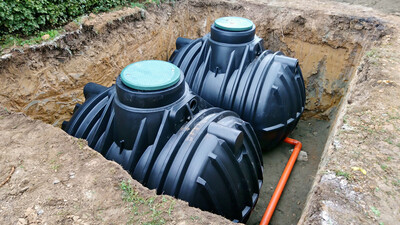With dry summers becoming the norm and water bills steadily increasing, rainwater harvesting is no longer limited to agricultural and horticultural users and homeowners are setting their sights higher than a small water butt for the garden.
With filters to remove moss, leaves and other debris that may wash off the roof with rainwater, rainwater harvesting systems provide a valuable source of water that while unsuitable for drinking, can be used to flush toilets, wash clothes and cars and water plants and lawns.
However, with rainwater harvesting tank capacity ranging from 1,500 to 15,000 litres, how do you know which is the right size for your property? Let’s look at the factors that go into making an accurate calculation.
What is the average rainfall in your area?
The amount of rain your area typically receives in the year will determine how much water you will be able to collect. This varies significantly throughout the UK, as the following data (annual averages between 1981 and 2010) from major cities illustrates.
- London = 592 mm per square metre
- Newcastle = 651 mm per square metre
- Birmingham = 681 mm per square metre
- Edinburgh = 730 mm per square metre
- Manchester = 829 mm per square metre
- Belfast = 861 mm per square metre
- Cardiff = 1152 mm per square metre
- Glasgow = 1245 mm per square metre
A more up-to-date figure for these cities and other areas can be easily found online by searching for “Average annual rainfall in [your area]”.
How much rainwater can you expect to harvest?
As rainwater is primarily harvested from the roof of a property, we can assume that by multiplying the average annual rainfall in your area by the square meterage of your roof, we can estimate the amount of rain you might expect to harvest each year.
The size of the roof can be calculated by multiplying the width of the house by its depth. Let’s say for example that you are three persons living in a two-bedroom terraced house in Birmingham with a 55 square metre roof area (the average for two-bed terrace houses).
Annual rainfall (m) x roof area (m² ) = rain collected (m³ )
0.681 x 55 = 37.455 m³
As one cubic metre is 1,000 litres, you can expect to harvest 37,455 litres of rainwater per year.
Of course, this is only a rough estimate as other factors will affect the true amount. For example, the rain may overshoot the gutters in high winds or heavy rainstorms and if the gutters are too small or not kept clear of leaves and debris, they may not be able to capture all the rain.
This method works easily for a house with a basic rectangular footprint; a more complex layout may take more ingenuity to estimate the roof area.
How many litres of rainwater do you need?
For this calculation, we can only work on average water usage as the true amount will vary between households.
Let’s say you want to use harvested rainwater to flush toilets and wash clothes. On average, we each flush 22.1 litres of water down the toilet every day, while a washing machine uses about 50 litres for an average cycle. Based on these averages:
- One person living alone and running 2 wash-loads per week will use 254.7 litres per week
- A household of 3 people running 6 wash-loads per week will use 764.1 litres per week
Want to include watering the garden and washing the car? Again, this depends on several factors:
- How large is your garden and how much of it needs watering (in addition to rainfall)?
- Do you use a watering can, garden hose or sprinkler?
- How many cars does the household own and how frequently are they washed?
- Do you use a bucket and sponge or pressure washer?
Let’s allocate 5 litres of water per person, per week for outdoor water use. This increases our estimates by 35 and 105 litres per week respectively. Now our estimated annual usage has risen to roughly 15,000 litres for a single-person occupancy and almost 45,200 litres for a three-person household.
On these calculations, our family of three in a two-bed Birmingham terrace might be 7,745 litres short of their requirement. However, rainwater harvesting is largely designed to reduce the consumption of mains water, not replace it, and will still reduce water bills considerably.
How much water do you need in reserve in case of drought?
The hot summers that we are becoming accustomed to have a profound effect on water supply. During most summers, water authorities in some parts of the country impose hosepipe bans and it’s quite feasible that in the event of a severe drought, even the mains water supply will be restricted.
If you are only relying on your rainwater harvesting system to keep your garden green during a hosepipe ban, you will need to stockpile less than if you anticipate restrictions on mains water supply and need it to flush toilets and wash clothes.
Based on the estimated figures above (or more accurate calculations if you’ve been able to obtain them), it’s generally recommended that you ensure your rainwater harvesting tank contains sufficient water for three consecutive weeks (21 days’ usage) without rain.
While we are unable to give you a watertight formula for accurately calculating your rainwater harvesting yield or requirements, we hope you have found this information helpful and interesting. If you have any further questions about rainwater harvesting systems, please call our friendly team of experts on 01420 555600 or email [email protected].
Also, look out for more articles in our ongoing series of blog posts, bringing you useful information, insights, guides and tips on all things drainage!

Written by
Bob Stone
Technical Sales
Heading up our Technical Estimating Department, Bob is our in-house quantity surveyor.

